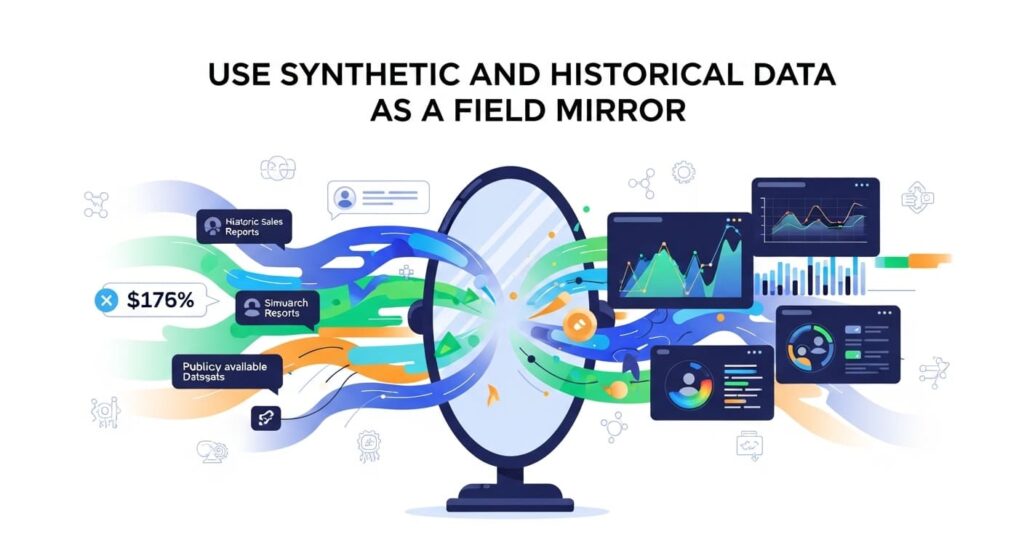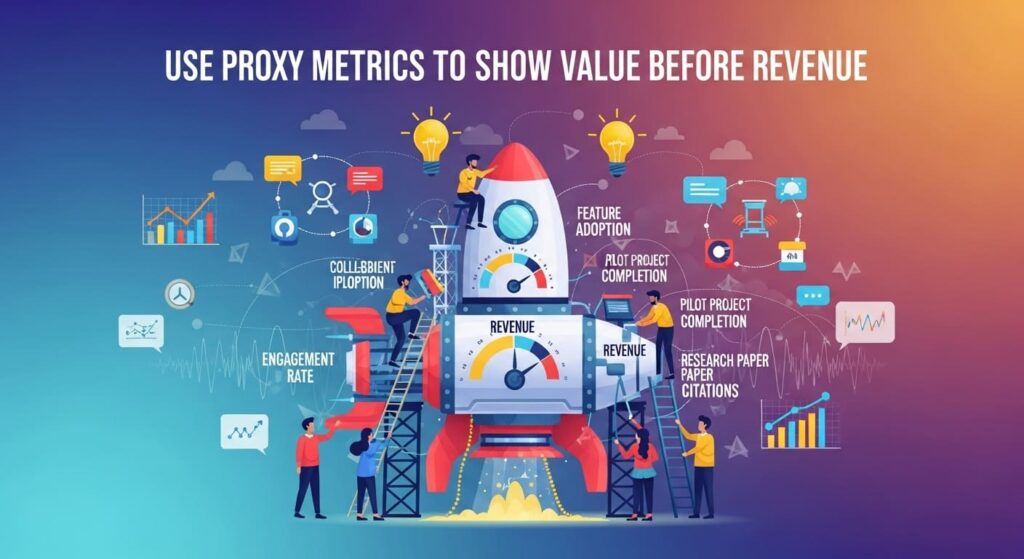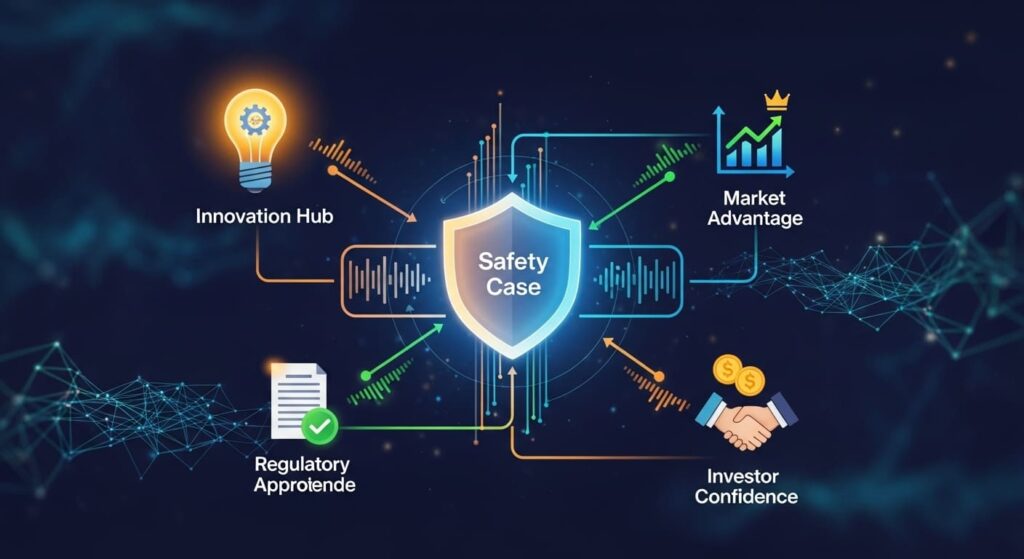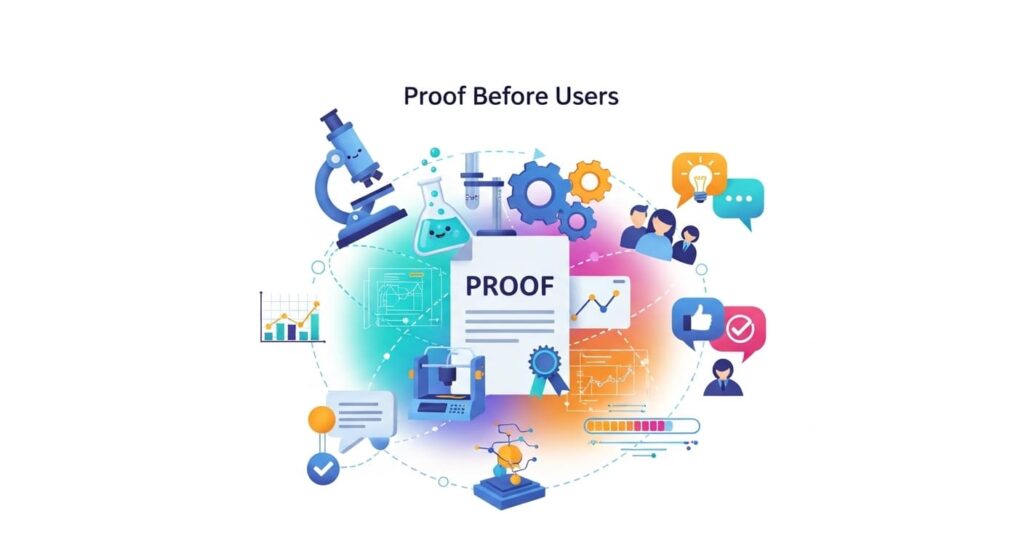Early on, you may not have real users yet. That’s normal in deep tech. Robots, labs, and complex systems take time to deploy. But you still need proof. You still need signals that say, “This works,” and, “This will win.” The good news: you can build real validation without a big user base. You can show clear value using smart stand-ins—safe tests, expert loops, and data that mirrors the field.
This guide shows simple ways to get hard proof before wide adoption. You’ll learn how to turn simulations, small pilots, expert panels, shadow runs, and partner sandboxes into crisp signals investors respect. We’ll keep it plain, tactical, and ready to run this week. And we’ll tie each move to IP you can protect, so your edge lasts when users do arrive.
If you want hands-on help, Tran.vc invests up to $50,000 in in-kind patent and IP services for AI, robotics, and deep tech teams. We roll up our sleeves with you—strategy, filings, and a clear story for your raise. Apply anytime at https://www.tran.vc/apply-now-form/.
Use High-Fidelity Simulation When You Can’t Touch the Real Line

You may not have a plant, a lab, or a fleet yet. That is fine. A strong simulation can act like your first user. The key is to make it honest, not glossy. When your sim mirrors real noise, real timing, and real limits, it gives you proof that carries weight in the room.
Choose scenes that actually happen
Start by naming three real scenes that your buyer faces on a normal week. A glare on the camera. A conveyor speed change. A reagent that ages by noon. Pick scenes that feel boring and painful, not heroic. These are the ones that decide if your tool sticks.
Build each scene with the same inputs and bounds the site would have. Use the real sensor specs, the true framerate, and the same compute cap they will let you install. Do not give yourself extra light or extra time. Tight limits make your win believable.
Document why you chose each scene in simple words. One paragraph per scene is enough. Later, when an investor asks “why this test,” you can answer in one breath. It shows care and respect for the buyer’s world.
Make outputs measurable, not pretty
Define one clear outcome for each scene before you write code. For vision, it could be “false rejects under two percent at 30 FPS.” For a robot, “safe pick in under four seconds with zero collisions.” State the unit, the threshold, and the clock.
Instrument the sim to log those units by run. Save inputs, choices, and results. Keep files small but traceable. Screenshots are helpful, but logs are proof. If you can replay a frame and show the same call, trust rises fast.
Share a tiny “sim report” with a plain table: scene, target, result, run count. Add one still image per scene. No heavy deck needed. A clean page beats a sizzle reel because it answers the real question: “Does it work under real limits?”
Turn sim wins into assets you own
If your method stays stable across changing light or drift, write down the steps in plain order: inputs, transforms, checks, fallbacks. That ordered flow is the core of your edge.
Draft a short provisional around that flow. Focus on the method, not the code. Cover the variations you tested in sim—different lenses, different speeds, different materials—so the claim spans the real world.
Tie the filing to the sim report in your data room. Now a partner sees a loop: honest scene → measured result → protected method. That loop is rare at pre-seed. Tran.vc helps you build it. If you want that support, apply at https://www.tran.vc/apply-now-form/.
Use Expert Panels as Your First “Users”

Experts are not buyers, but they are close to the work. A small panel can pressure-test your assumptions before you touch a site. Done well, this is faster than a pilot and cheaper than a miss.
Recruit people who live the task
Invite hands-on operators, not just executives. A shift lead, a senior tech, a quality engineer who closes CAPAs. Put names, not titles, in your plan. You want people who can say, “Here is how it breaks on Tuesday.”
Aim for variety inside a tight niche. Three plants with similar lines and different lighting. Two labs with the same workflow but different sample prep. Small differences expose blind spots you would miss alone.
Offer a clear give-get. They give one hour each week for three weeks. You give early access, a simple stipend, and first shot at a small, safe pilot. Set dates up front so the group shows up ready.
Run sessions that force real choices
Structure each call around one scene and one artifact. A short clip, a spec draft, a dry-run video. Ask them to mark pass/fail and explain why in their own words. Avoid theory. Ask about the last time they saw the same scene live.
Collect numbers where you can. “How often is this glare type?” “How long until a reset?” “What would be acceptable here?” These numbers shape your targets. They also give you a price frame later.
Close each session with one change you will ship before the next call. Then show that change working. The panel stops being a chat and becomes a build loop. Momentum builds trust, and trust opens doors.
Convert opinions into usable proof
Transcribe short quotes and tag them by role and scene. Pick three that name pain in plain words. Keep them raw. You will use them in your deck and in your outreach. Real words sell.
Summarize the panel’s “accept” thresholds in a one-page memo. State the numbers and the context. “At 30 FPS under sodium light, false rejects must stay under two percent.” This memo becomes your spec for sim and for pilots.
If a unique check or fallback keeps showing up as the reason experts say “yes,” capture it as a method. That is claim fodder. Filing now means the trick that wins the panel cannot be copied when you start to scale.
Use Synthetic and Historical Data as a Field Mirror

You can learn a lot from data you create or borrow. The trick is to keep it honest. Synthetic data should match the mess of the real world. Historical data should be labeled with care and context.
Build synthetic data that hurts a little
Start from real stats. Use the actual noise levels, blur, jitter, and occlusions you expect. Make bad cases common enough to matter. A perfect set will lie to you. A gritty set will teach you.
Generate small batches and test often. Ten thousand frames that match your three scenes beat a million clean frames. Use each batch to tune your method, then refresh with a new seed so you do not overfit to your own noise.
Write a short “recipe” for the generator. Inputs, ranges, and reasons. This recipe proves you thought about reality. It also becomes part of a data pipeline you can protect if it is novel and useful.
Validate with a rough ground truth
Pair your synthetic set with a small, hand-labeled real set. It does not need to be large. It needs to be clean and diverse. Use it to spot gaps in your generator and to calibrate your thresholds.
Track error by cause, not just by count. Misses under glare are not the same as misses from motion. Cause tags let you focus fixes where they pay off. They also make your progress easy to explain in one slide.
Update the small real set each month with a few tricky cases. This rolling truth set keeps you honest and prevents drift. It also gives you fresh proof for sales notes and investor updates.
Lock the dataset method as part of your moat
If your way of generating or selecting hard cases is new and practical, treat it like product. Document it, name it, and consider filing. A method that makes models robust with less real data is valuable.
Package the method and the metrics in a tidy folder: recipe, sample outputs, error by cause, and the change you shipped because of it. This is not fluff. It is diligence-ready proof.
Tran.vc helps teams turn data methods into claims that stand. We invest up to $50,000 in in-kind IP work so you can build with speed and protect the parts that matter. Start here: https://www.tran.vc/apply-now-form/.
Run Shadow Deployments to Prove Safety Without Risk

A shadow run is when your system watches but does not control. It makes the call in parallel while the human or legacy tool still owns the action. This is how you earn trust fast without asking for the keys on day one.
Design a shadow that matches real pace
Place your system on the real feed with the same latency bounds. Do not downsample unless the site does. Your calls should arrive in time to matter, even if they are not used yet.
Log your decision, the time it took, and the confidence. Log the operator’s actual action. You are building pairs: what you would have done, what they did. Pairs turn into learning and into crisp claims later.
Set a clear window for the run. Two weeks on two shifts is often enough to see patterns. Short windows keep focus tight and reduce the chance of “shadow forever,” which helps no one.
Score decisions with a fair rubric
Agree up front on what counts as right, wrong, and safe. Use simple categories: correct pass, correct fail, false reject, false accept, and defer to human. Add a “safety override” flag when your system would have slowed or stopped.
Review a small, random sample with the site lead every few days. Resolve disagreements in the moment. Store the rulings. This builds a shared truth and avoids end-of-pilot debates that stall deals.
Report with humility. If your system deferred in a hard case, say so and show why. Defer is often the safe choice early. Buyers respect honesty more than bravado. It sets the tone for a clean next step.
Use shadow learning to shape a small paid pilot
Turn the top two fail causes into the first two fixes. Ship them. Then propose a tiny, controlled step where your system acts under a narrow guardrail. “We control X only when Y is true.”
Price the step modestly with a clear clock. Promise one metric move tied to the shadow score. This keeps momentum and turns your proof into dollars without a long legal slog.
Capture any novel guardrail or arbitration logic you created during shadow. This is often the real engine of safety. If it is new and useful, claim it. It will be hard to copy later without crossing your lines.
Build Partner Sandboxes That Act Like Early Sites

Sometimes the fastest path to proof is not a live floor—it is a partner’s controlled space that looks and feels real. A good sandbox gives you the inputs, the timing, and the stress you need without the risk of downtime. It also creates a clean story everyone can share.
Set the sandbox to match real limits
Open by agreeing on exact constraints: sensor types, lighting, speed, latency, and compute budget. Keep the setup plain and strict. When your rig matches the partner’s typical site, wins in the sandbox translate. People trust numbers that survive tight bounds more than glossy lab demos.
Ask the partner to supply normal and bad cases. Normal keeps you honest. Bad cases—glare, drift, occlusion, out-of-spec samples—teach you where to build guardrails. Record why each case matters in one sentence so later readers understand the scene.
Run short cycles. Two or three days per scenario is enough if logging is clear. Tight loops help your team ship fixes between sessions. Momentum builds belief on both sides and makes approvals smoother for the next step.
Measure what the site lead actually cares about
Before the first run, name one outcome for each scenario. It might be fewer false rejects at a given speed, or safe motion within a time cap. Use the partner’s words for units and thresholds so readings feel familiar.
Log every attempt. Save inputs, decisions, and time to decision. If your system defers to human, mark it and why. Defers are not failures when they avoid risk; they are proof of caution, which buyers value early.
Share results in a single page after each block. Put a tiny table with target and actual, plus one still frame. Notes should explain adjustments you made and what changed. This discipline turns a sandbox into a reliable surrogate for a site.
Turn the sandbox into a repeatable asset
Freeze each tested scenario as a bundle: data clip, config, target, and outcome. Give the bundle a stable name so your team can rerun it before releases. This becomes your “field-in-a-box” suite.
If a method improved outcomes across multiple bundles—say, a new planner under mixed light—document the steps. When the steps are novel and useful, file a provisional. You are protecting the engine that survived realistic stress.
Credit the partner in a neutral note if allowed. Two paragraphs, one chart, no hype. Add it to your data room and your deck. It shows you can win outside your office. Tran.vc can help package these into IP-backed proof; apply at https://www.tran.vc/apply-now-form/.
Use Proxy Metrics to Show Value Before Revenue

You may not have invoices yet. You can still prove worth with clean proxies tied to the job. A proxy is a measurable stand-in that maps to time, cost, or risk your buyer understands.
Pick proxies that map to money or safety
Choose one proxy per job. For inspection, it could be minutes per changeover, false rejects at target speed, or time to safe resume after drift. For lab work, it could be sample prep time or rework rate. Keep the proxy close to the pain.
Confirm with a manager that the proxy links to dollars or risk. Ask how they report it today and who reads the report. When the link is explicit, your later price talk lands. You are not arguing theory; you are improving their own number.
Write the mapping in one line: “Cutting re-teach minutes raises uptime,” or “Fewer false rejects reduce scrap.” This line appears on your pilot sheet, your update, and your deck. Consistency breeds trust.
Measure proxies with stable methods
Instrument your product to record the proxy the same way, every time. If the proxy lives outside your tool—like uptime—agree on a shared source with the buyer. Pull a sample together to check alignment.
Track cause tags. A faster changeover due to presets is not the same as a faster changeover due to better detection. Cause tags help you repeat wins and explain them later. They also reveal what to protect in IP.
Plot improvement by cohort of sites or sessions, not by a rolling average. Cohorts show that gains persist with new runs, which beats a one-off spike. Investors read this quickly and believe it.
Turn proxies into early pricing and IP
Once a proxy moves, offer a small paid step anchored to it. Price modestly against the value range the proxy implies. You are not squeezing dollars; you are proving fairness.
If the improvement depends on a method that selects, scores, or guards in a new way, draft claims around that flow. Proxies then support utility: they show the method changes outcomes that matter.
Present the trio—proxy baseline, lift, and filing—in one slide. Calm facts win the room. Tran.vc helps founders tie proxy gains to smart claims so your early wins become durable assets.
Treat Safety Cases as Strategic Assets

In robotics and AI, safety is not a checkbox. It is your passport to production. A crisp safety case shows how your system avoids harm and recovers fast. It also lowers sales friction and strengthens your moat.
Write the case like a story, not a thesis
Open with the system boundary in plain words. Name what you sense, what you decide, and what you never do. This reduces fear. People relax when they know the edges.
List the top hazards you learned from panels, sandboxes, or shadow runs. For each, describe your detect, decide, and act steps. Keep it readable. Short sentences beat dense diagrams for first passes.
End with testing you ran: sims, sandbox bundles, or shadow pairs. Link each hazard to a proof artifact. Now your case is not just claims; it is verified behavior. That is rare and powerful at pre-seed.
Keep the case alive with real logs
Add a lightweight incident log. When guardrails fire, record what, why, and outcome. Review weekly. Most entries will be routine; patterns will point to simple fixes that also help retention.
When you ship a safety improvement, tag it in your case and your metrics doc with a date. Over time, your case becomes a timeline of risk reduction. Legal and buyers love timelines more than slogans.
Share an abridged version with prospects early. A short, clear PDF can cut weeks from security reviews. Faster reviews mean faster pilots, which move your whole plan forward.
Protect novel guardrails and arbitration logic
If your way of blending sensor signals, scoring confidence, or arbitrating actions is new and practical, write it as a method. Inputs, thresholds, fallback actions, human-in-the-loop steps—keep the sequence tight.
File quickly if it drives acceptance or retention. Safety logic that buyers trust is hard to displace; once protected, it anchors price and slows copycats.
Tran.vc partners with founders to turn safety cases into IP that carries weight. We invest up to $50,000 in in-kind patent work to make this real. Apply at https://www.tran.vc/apply-now-form/.
Package All Proof in a Deck People Can Carry

You want a deck that someone else can present without you. That means tight slides, plain words, and assets that answer real doubts. Keep the focus on outcomes under real limits.
Lead with the job and the scenes
Open with the job to be done in one line, then show the three field scenes you chose. Put a sentence under each scene saying why it matters. This grounds the rest of the talk in reality, not buzz.
Follow with one page per scene: target, result, and a small image. Use the same layout for each so the eyes learn the pattern. Consistency reduces cognitive load and raises trust.
Add a quiet footer: “tested at X FPS on Y hardware; sodium light; mixed parts.” Tiny details do more work than adjectives. They also defend you in partner meetings later.
Put your methods beside measured results
For each result, show the method that made it possible as a simple flow: inputs, transforms, checks, fallbacks. Keep it to a few boxes. Then note “provisional filed” or “claims in prep” where true.
Explain learning loops in one sentence above the chart: “Panel → change → sandbox lift,” or “Shadow → fix → safe control under guardrail.” Loops tell partners you can improve without luck.
Use real quotes near charts. Short, raw lines from operators beat any tagline. People remember them. They retell them inside their firms. That is how deals move.
Close with a small, paid next step and a clean ask
Offer a narrow pilot tied to one scene, one proxy metric, and one guardrail. Name owners, dates, and success criteria in buyer language. Invite a decision in days, not months.
Include your security and safety one-pagers in the appendix. When someone asks, you can flip and answer in thirty seconds. Fast answers win rooms.
End with your CTA for partners and investors: “Two lines, two weeks, one guardrail-controlled step.” If you want help shaping this package and filing around the engine behind it, Tran.vc is ready to work with you. Apply at https://www.tran.vc/apply-now-form/.
Leverage Independent Benchmarks and Certifications

When you lack live users, a trusted third party can play that role. A clear pass on a known benchmark, or a small certification that fits your niche, tells buyers your system meets a bar that others respect. It also shortens fear-based delays because you answer risk with proof, not talk.
Pick the right bar for your wedge
Start with the standard your buyer already cites. A factory may reference safety norms. A lab may follow quality rules. A cloud buyer may require a tight security baseline. Choose one bar that matches your first use case so the result feels relevant on day one.
Read the scope line by line and map it to your product boundary. Write in plain words what you will test, what you will not test, and why that choice matches the job to be done. This avoids drift into a long checklist that does not help sales.
If the full certification is heavy, choose a focused pre-assessment with a narrow scope. A small, fast pass that matches your wedge is more useful than a giant project that takes a year. You want momentum now and depth later.
Run the tests in the open with tight scope
Before testing, freeze configs, hardware, and data sources. Share them with the assessor so the run can be repeated. When a result can be replayed, trust rises because people can see cause and effect.
Invite your future champion to observe one short session. Let them see how scenes are picked, how calls are scored, and how guardrails act. A single hour in the room will do more than a long email thread. It turns audit into shared learning.
When the assessor finds gaps, log them without spin. Ship one fix and retest that gap fast. Each closed gap is a line in your update and a slide in your deck. It shows you learn in weeks, not quarters, which is what buyers want to see.
Turn certificates into sales tools and IP
Publish a one-page summary in plain words. State the bar, the scope, the pass criteria, and the outcome. Add a small image or diagram. Buyers forward short, clear pages. Long binders gather dust.
Pair the pass with a tiny pilot offer. “We met the bar under these limits; now let’s run one guarded step on your line for two weeks.” The pass lowers fear. The pilot converts that comfort into action.
If a unique method helped you meet the bar with less setup or higher safety, write it down as steps and file a provisional. A certified method that others cannot copy becomes a real moat. Tran.vc can help you select and protect that method while you scale. Apply anytime at https://www.tran.vc/apply-now-form/.
Conclusion: Proof Before Users

You do not need a crowd to show you are real. You can use sims that match the floor, panels that speak the truth, data that mirrors the mess, shadows that run in parallel, and sandboxes that feel like live sites. You can score each scene with clear targets, log what happened, and show steady lifts. This is proof. It travels. It opens doors.
Keep the loop tight. Pick one scene, name one metric, ship one change, and run the same test again. Save the clip. Save the log. Save the quote. When a method makes the result repeat under hard limits, write it down as steps and protect it. Now your early wins become assets you own, not just moments you remember.
Bring it all together in a calm deck. Lead with the job. Show the three scenes. Put the target next to the result. Add the method as a small flow. Close with a small, paid step under a clear guardrail. People will say yes because the path is safe and the value is plain.
If you want a partner to help you do this well, Tran.vc invests up to $50,000 in in-kind patent and IP services for AI, robotics, and deep tech teams. We help you turn stand-ins into solid proof and proof into protected moat—so you raise with leverage, not luck. Apply anytime at https://www.tran.vc/apply-now-form/.
